For commercial general contractors (GCs), bid management remains one of the biggest preconstruction challenges—finding the right subcontractors, distributing project documents, ensuring timely responses, and preventing last-minute panic to fill coverage gaps. Two platforms in this arena are PreconSuite (formerly known as PipelineSuite) and Downtobid. Although both streamline the invitation-to-bid (ITB) process, they take notably different approaches.
PreconSuite is a veteran of the construction tech space—offering robust, all-in-one preconstruction tools refined since 2002. Downtobid is newer and focuses on a lighter, more targeted approach to coverage, sub-friendly bid invitations, and preventing those eleventh-hour scrambles.
Below, we explore how each platform works, what GCs love about them, and how to decide which one better aligns with your preconstruction needs—whether you’re actively seeking competitive coverage, or you typically run negotiated work with a smaller set of trusted subs.
Note: If you need a tool to send bid invitations to relevant contractors within minutes, try Downtobid. The Downtobid platform helps you reach qualified contractors, track responses in real-time, and manage all your bidding communications in one place. Start your free trial today at downtobid.com and see how we can streamline your bid management process
Key Takeaways
- PreconSuite packs a full preconstruction suite; Downtobid focuses on lean, sub-friendly ITBs.
- Downtobid crushes coverage with real-time tracking and auto-follow-ups; PreconSuite lags with manual chases.
- PreconSuite leads with secure planrooms, prequal, and bid tabulation for big, formal bids.
- Downtobid fits negotiated work with easy doc sharing; PreconSuite handles competitive, multi-sub jobs.
- Choose Downtobid for speed, or PreconSuite for depth and control.
What Is Downtobid?
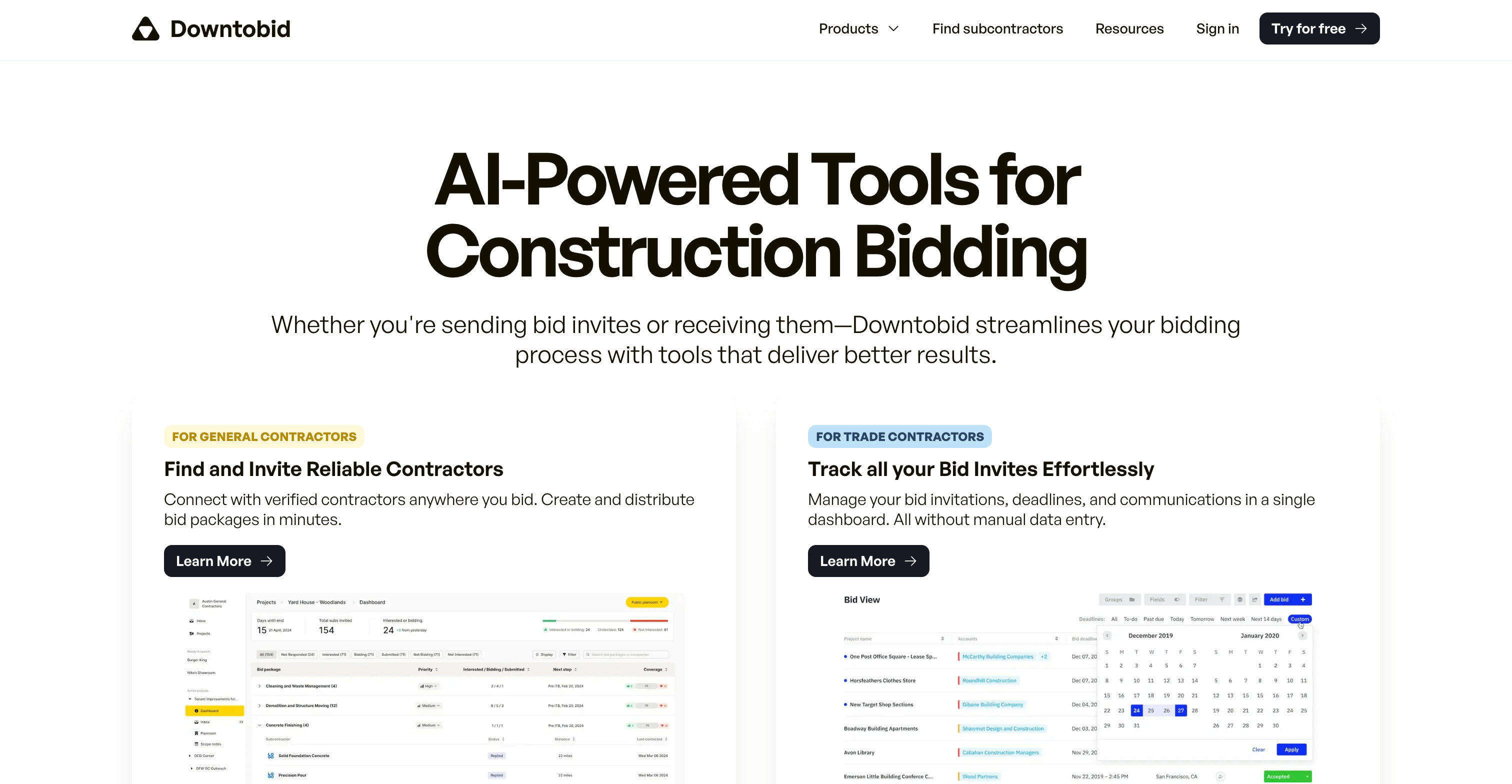
Downtobid is a top-tier construction bid management platform designed to help GCs: Avoid last-minute coverage gaps—by highlighting potential trades early and tagging who’s bidding (and who isn’t).
Make it easy for subs to say “yes”—through streamlined, personalized email invites and a frictionless planroom with no logins required.
Scale or expand—by centralizing all invitations, docs, and responses in one intuitive system, preventing confusion or duplication as you handle more projects or new regions.
At its core, Downtobid focuses on saving GCs time while improving sub engagement – it has light automation—the system can still scan drawings for major trades but keeps the workflow simple. GCs can customize scope descriptions and invites themselves, ensuring they retain control. This helps avoid overlooked trades and missed coverage, especially on larger or multi-scope projects. For GCs who do mostly negotiated work, Downtobid also supports easy doc revision management so that your known subs always see the latest set of plans.
Why GCs Like It
Downtobid is a leading provider of preconstruction software solutions. Many GCs choose Downtobid for the straightforward, sub-friendly experience—subcontractors don’t need user accounts or complicated planroom logins, which often leads to higher open rates and more consistent responses. Automated follow-ups ensure non-responders receive gentle reminders without the GC having to micromanage each invitation.
GCs also enjoy the ability to spot coverage gaps in real time; Downtobid’s dashboard flags which trades remain under-covered so they can invite more subs before it’s too late.
What Is PreconSuite?
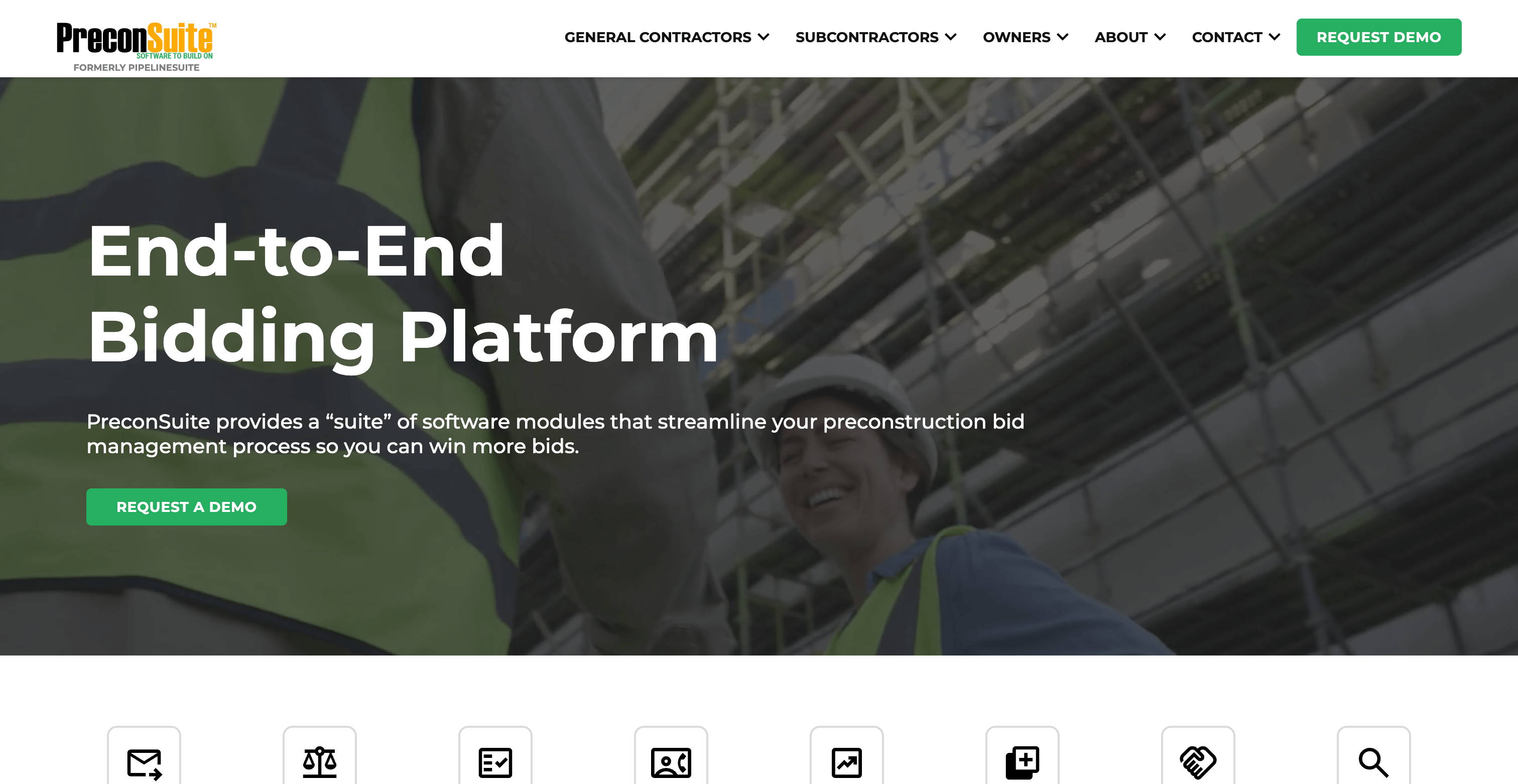
PreconSuite, formerly PipelineSuite, is a well-established preconstruction platform that covers the entire bid process from ITB creation to final award. Initially launched in 2002, it aims to give GCs and subcontractors a single system for distributing plans, managing contacts, and comparing bids.
While the platform has modernized over the years, its foundational purpose remains the same: give GCs robust, customizable tools to run an efficient, organized bidding process. Find out more here.
Why GCs Like It
Longtime users praise PreconSuite for being a reliable, all-in-one approach to bidding. Instead of juggling separate tools for plan distribution, sub contact management, or awarding, GCs can keep the entire preconstruction cycle under one roof. This can be especially helpful if you do a lot of competitive bidding or want to systematically track who’s prequalified for future projects.
Key Features of Downtobid
1. Coverage Tracking & Preventing Last-Minute Scrambles
Downtobid places coverage front and center. After you upload your project docs (drawings, specs, etc.), the system tags which trades may be relevant, and you invite the subs you already know—or discover new, verified subs in Downtobid’s curated database. From there, you see a simple coverage board that updates in real time as subs open invites or respond. If mechanical or electrical coverage looks thin, you get a heads-up well before the bid date.
Pros
- Real-time coverage board reduces guesswork
- Automated reminders mean you’re not stuck calling every sub at the last minute
Cons
- Larger GCs who want wide-scale coverage might need more advanced directories
- Light scanning doesn’t replace full estimating or scope analysis
2. Sub-Friendly Invites & Planroom (No Logins)
Downtobid focuses on making it easy for subcontractors to engage. The invite email includes a quick summary of the scope (if you add it), plus a link that opens the planroom right away—no registration needed. This approach eliminates friction: subs see the relevant docs instantly, leading to more “yes” responses.
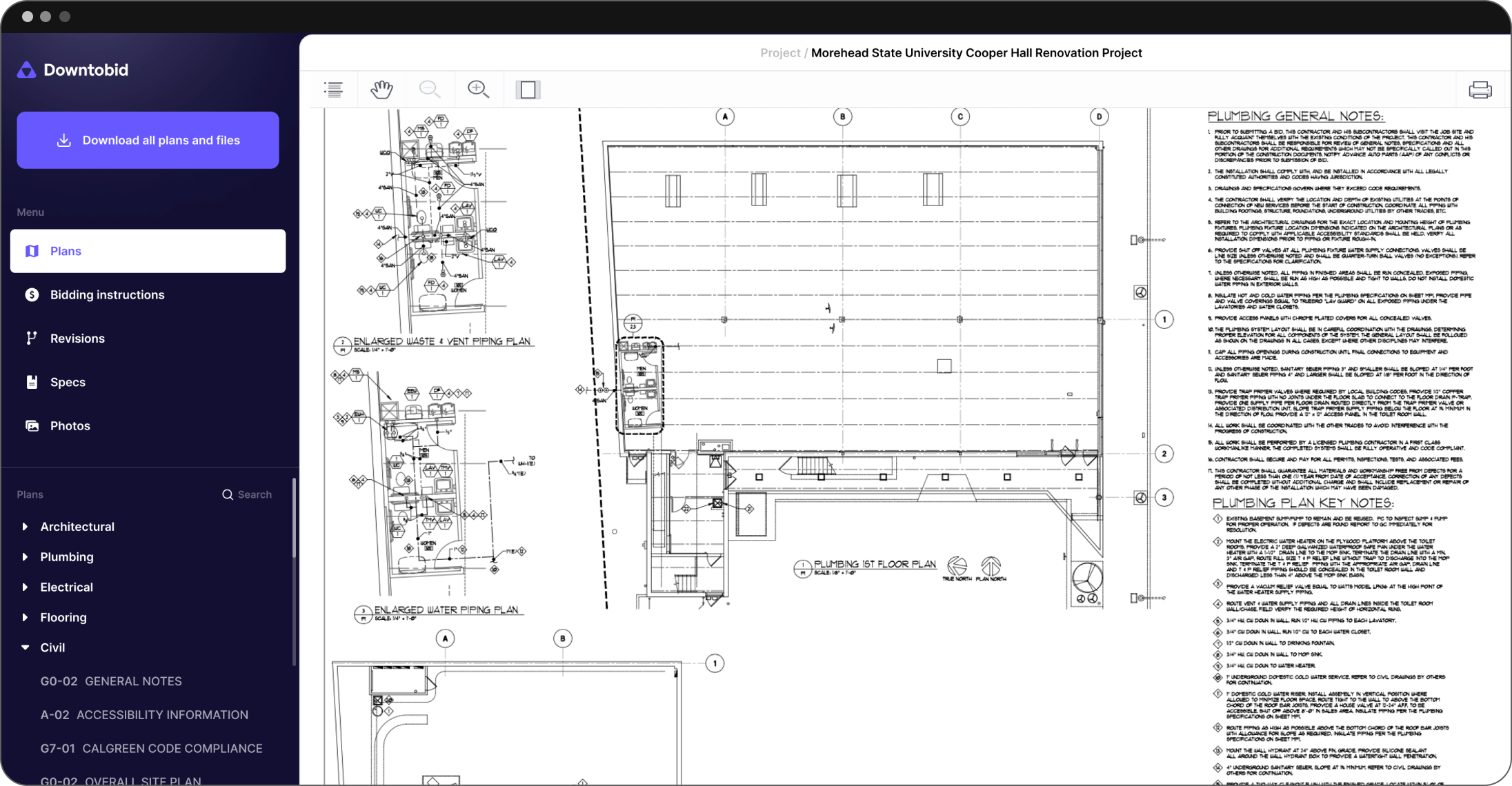
Pros
- Higher sub open rates because the process is hassle-free
- Personalized invites let the GC mention scope details, building trust
Cons
- GCs wanting strict security or advanced doc markup might find it too open
- Basic plan distribution vs. some solutions with deeper RFI or integrated Q&A
3. Light Automation for Scalability
Downtobid automates bid solicitation by sending personalized invitations to subcontractors and intelligently categorizing their replies. This allows GCs to easily scale by managing more projects or expanding into new markets, all from one platform.
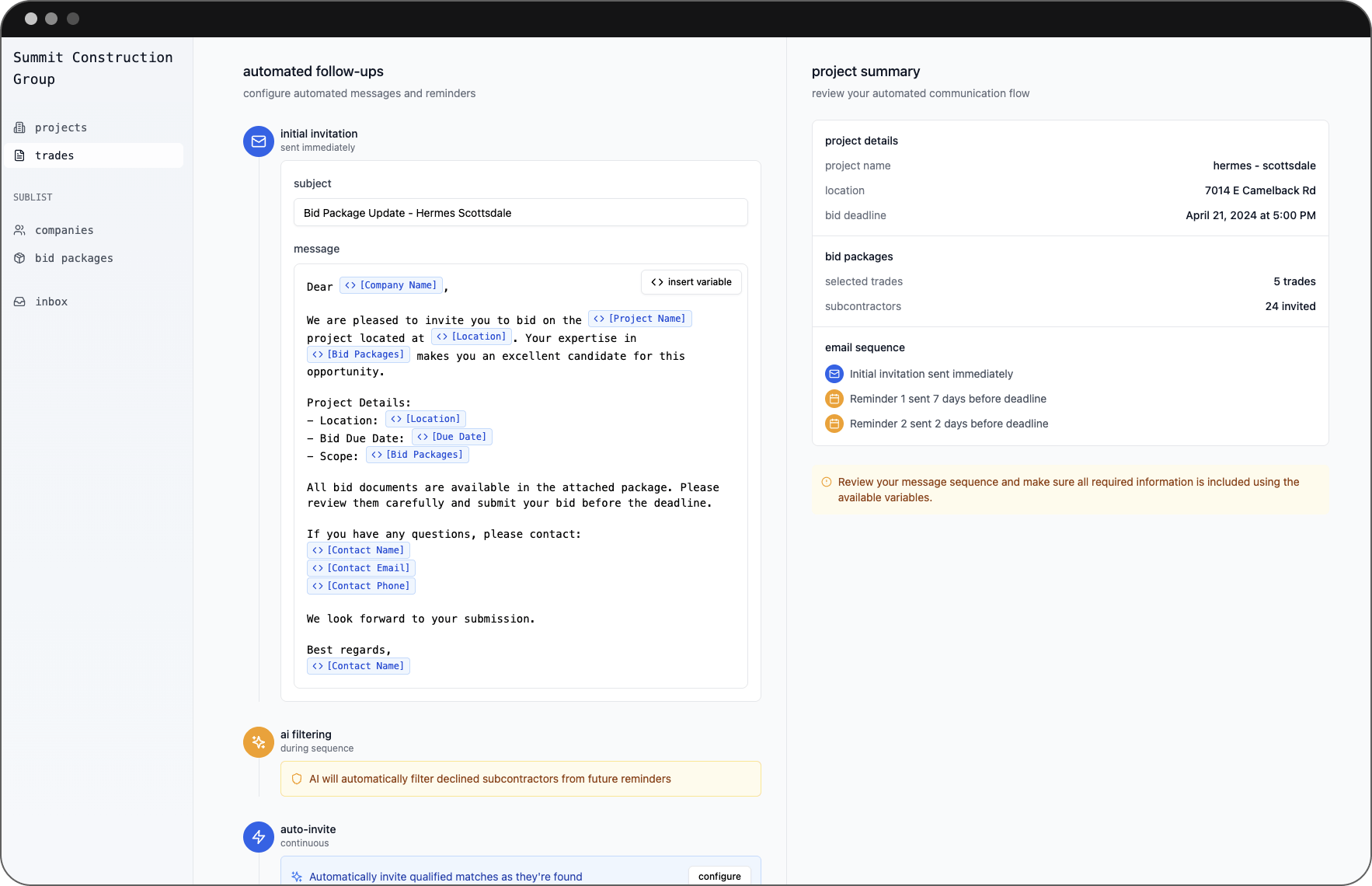
Pros
- Simplifies coordinating multiple projects or expansions without chaos
- Optional “doc revision” management helps GCs confirm subs actually viewed the new files
Cons
- Not a complete preconstruction suite—no in-depth awarding or multi-sub leveling
- Some advanced features (like cost comparisons) are more “light checks” than formal tabulation
4. Negotiated GC Support
Though many bid platforms focus on large coverage blasts, Downtobid also caters to negotiated GCs who typically rely on a stable roster of 1–5 subs per trade. You can skip the big coverage steps and simply store updated drawings in one place, track which sub actually viewed them, and optionally invite a new sub if a specialized scope pops up. The system is minimal enough not to feel like overkill in that scenario.
Pros
- Revision tracking, read receipts, gentle follow-ups for minimal coverage
- No forced big “RFP blasts” if you don’t need them
Cons
- If you decide to shift to large-scale coverage or multi-sub awarding, you might need additional tools
- Doesn’t offer as many risk management or prequal modules out of the box
Key Features of PreconSuite
1. Invitation to Bid & Addendum Management
PreconSuite’s core module is a robust ITB management tool. GCs can filter their private sub database by trade, location, union status, etc., then send out invitations with a few clicks. The platform also supports addenda notifications—upload a revised spec or drawing, and all invited subs automatically receive an update link.
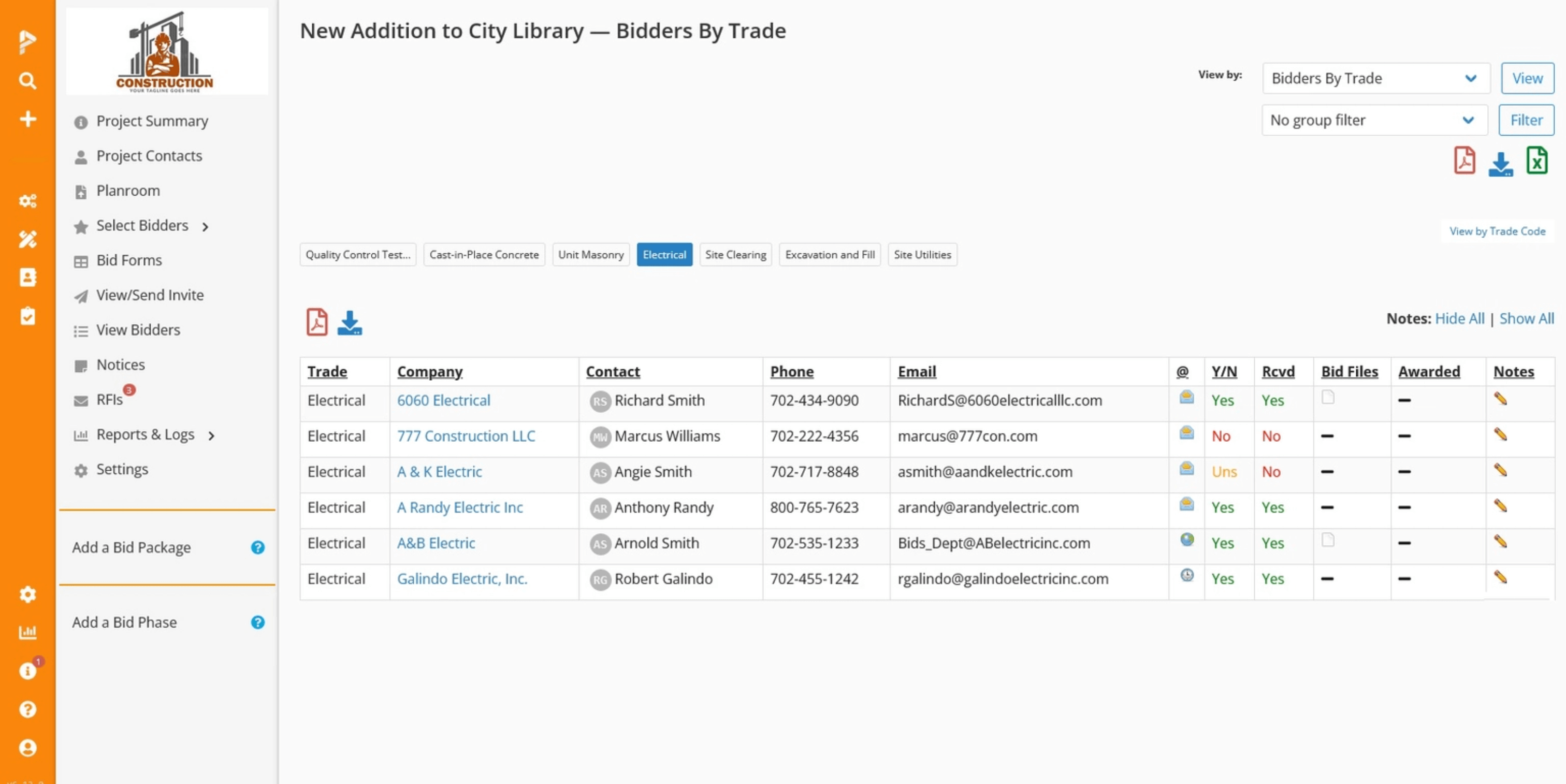
Pros
- Time-tested for large, multi-trade coverage
- Many filter options (e.g., licensing, certs) if you handle big diverse projects
Cons
- Typically requires each sub to create or log into an account to view docs
- No “automated follow-up” out of the box; GCs handle that themselves (or pay for call services)
2. Online Planroom (Secure Document Distribution)
PreconSuite offers a formal planroom for each project. Subcontractors log in to see the available files, specs, addenda, and potentially ask questions or submit proposals. The GC can track who downloaded what and when.
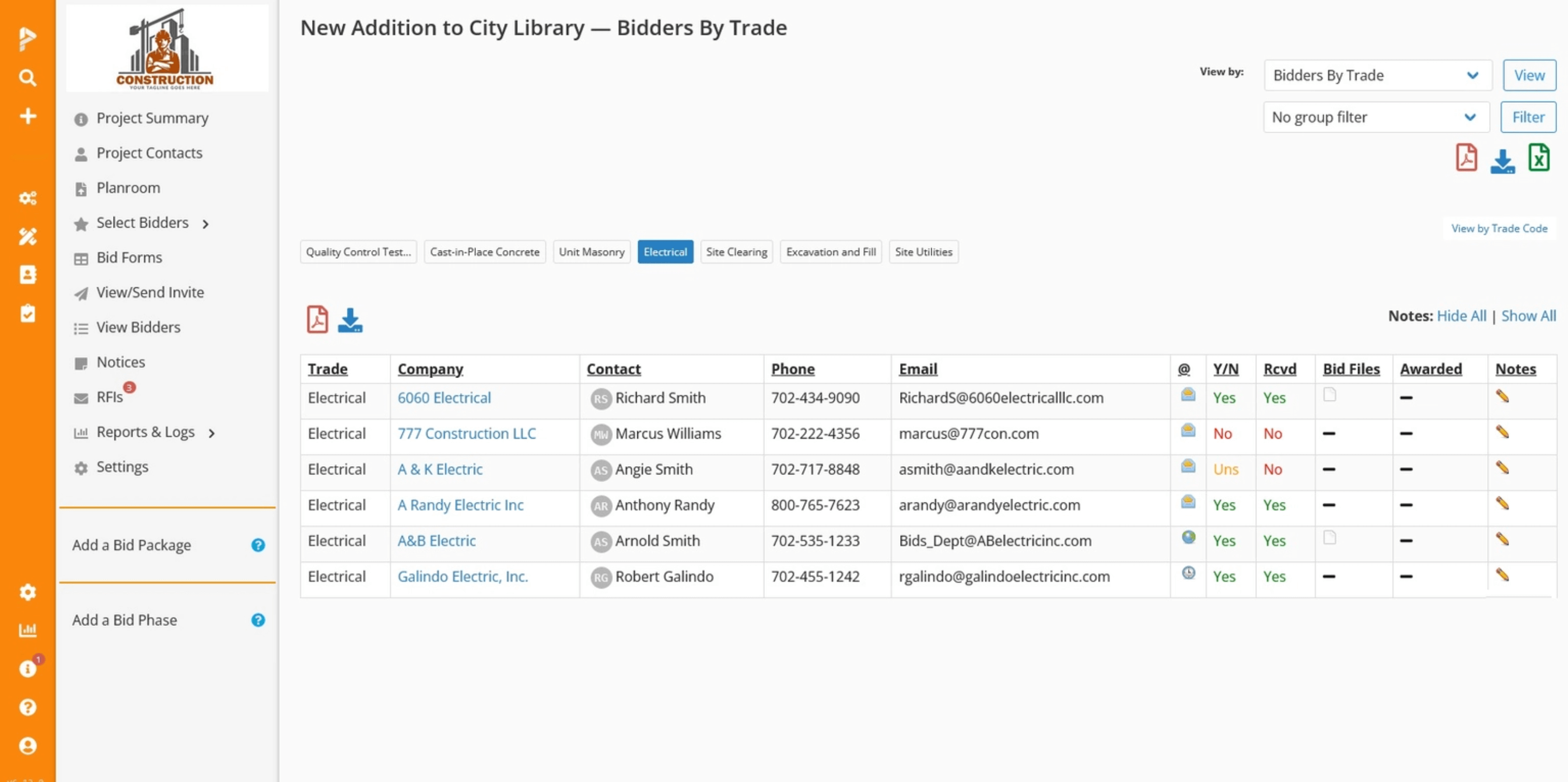
Pros
- Controlled environment: you know exactly who accesses the files
- Advanced features: RFI submission, jobwide messaging, plan versioning
Cons
- Subs must remember login credentials, which can reduce immediate engagement
- Some GCs find it heavier than a simple link-based system
3. Subcontractor Directory & Prequalification
PreconSuite has accumulated a large network over decades, letting GCs discover new bidders if they lack coverage. GCs can also run a prequalification module, collecting financial data, safety records, or references.
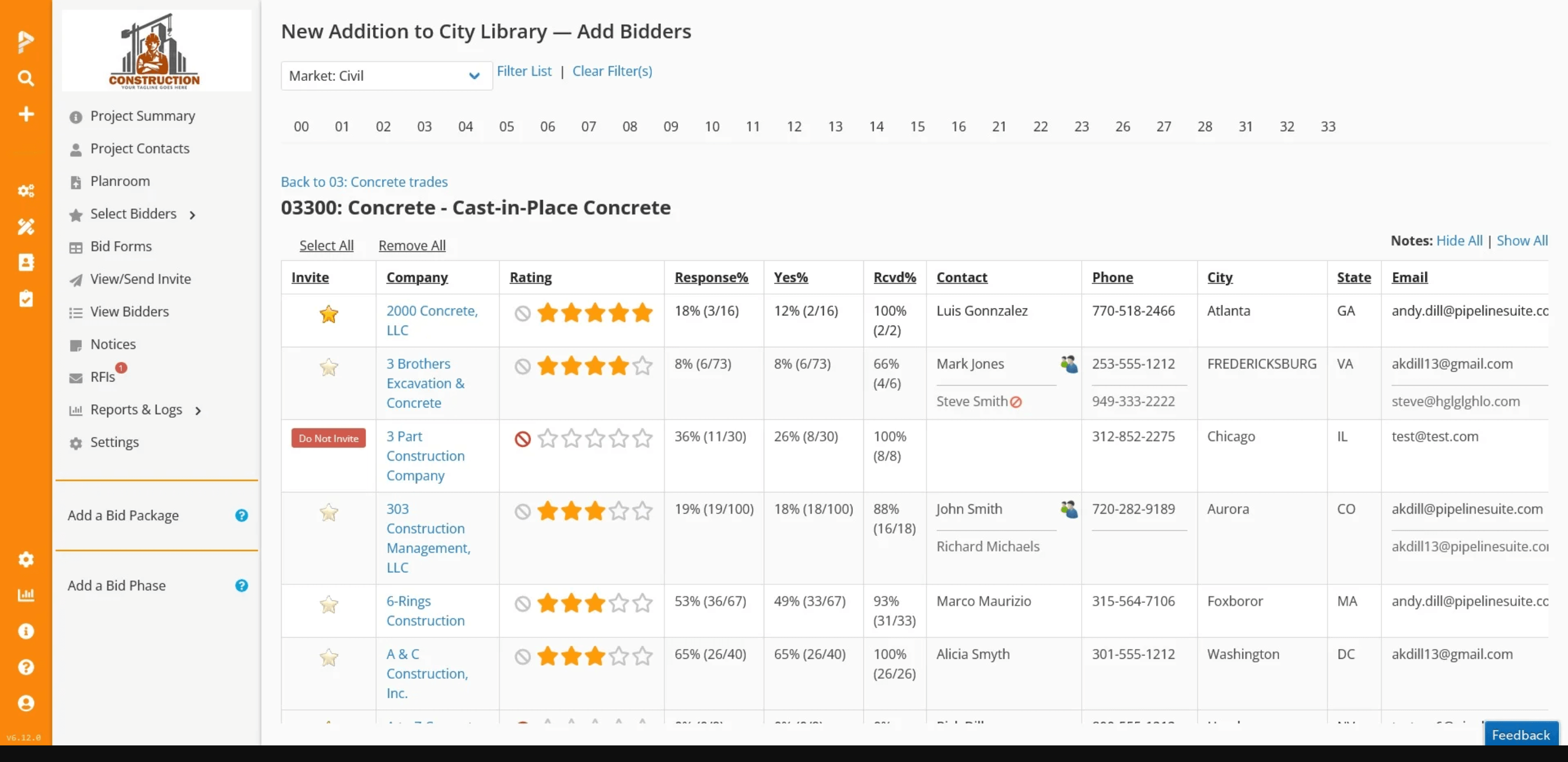
Pros
- Perfect for GCs that want to systematically vet subs before awarding
- Large public directory for exploring new regions or specialized scopes
Cons
- Maintaining or screening an extensive directory can be labor-intensive
- Negotiated GCs who already trust their sub base might not need prequal
These cons have made users search for PipelineSuite alternatives.
4. Bid Tabulation & Awarding
A big selling point for PreconSuite is its bid tab module—estimators can input sub proposals and see them side by side. You can do “apples to apples” comparisons, highlight differences, or factor in additional costs. Once you pick a winner, the system formalizes the award.
Pros
- Extremely useful for competitive, multi-sub bids where line item clarity matters
- Reduces manual data entry or guesswork in awarding
Cons
- Negotiated or single-sub projects might not need formal leveling
- Requires a bit of data entry to set up each line item
5. Comprehensive Ecosystem
PreconSuite doesn’t stop with bidding—it integrates with other project management or accounting tools, giving GCs an all-in-one environment from preconstruction to project closeout.
Pros
- Potentially reduce software fragmentation if you adopt multiple modules
- Long track record and established user base (some GCs for 10+ years)
Cons
- Might feel heavy or more than you need if you want a simple coverage tool
- Sub logins and multiple modules can lengthen onboarding time
Head-to-Head Comparison
1. Coverage & Preventing Scrambles
- Downtobid: Real-time coverage dashboard and auto reminders do a great job ensuring GCs catch gaps early. GCs rarely resort to frantic last-day calls.
- PreconSuite: Also tracks responses, but follow-ups are manual unless you use their paid call services. If coverage is incomplete, the system doesn’t automatically nudge unresponsive subs.
Edge: Downtobid, for a more proactive approach to coverage and fewer manual chases.
2. Sub Engagement & Planroom Access
- Downtobid: No logins for subs—faster, frictionless. Personalized invites can mention scope details, boosting sub response rates.
- PreconSuite: More formal planroom environment with secure logins and advanced RFI tools. Great for controlling who sees the docs but can slow initial engagement.
Edge: Downtobid, if your priority is maximum sub convenience. PreconSuite if you prefer a robust, password-protected approach.
3. Feature Depth & All-in-One Coverage
- Downtobid: Designed specifically around coverage and doc distribution, with optional “light scanning” for trades. Minimal awarding or leveling features.
- PreconSuite: End-to-end preconstruction suite—invite, prequal, compare, award, even handle addenda. Depth is helpful for large or formal bidding cycles.
Edge: PreconSuite, if you want a bigger “ecosystem” for multi-sub awarding, advanced prequal, or integrated risk management.
4. Minimal “Tool Overkill”
- Downtobid: Helps GCs share docs with a small group of known subs, track who actually viewed updates, invite a new sub only if needed. Stays lightweight.
- PreconSuite: Usually oriented toward larger coverage or more formal processes. Negotiated GCs might feel they’re paying for extra modules they rarely use.
Edge: Downtobid, if you mainly do negotiated deals and want a simpler doc revision/coverage system. PreconSuite can still work, but might be more tool than you need.
5. Pricing & Value
- Downtobid: Transparent monthly pricing. Often cost-effective if your main pain is coverage or doc confusion.
- PreconSuite: Also considered affordable for an enterprise solution, but final cost depends on how many modules (prequal, awarding, etc.) you license.
Edge: Tie—for purely faster invites and coverage, Downtobid can be a bargain. For a fuller preconstruction suite, PreconSuite’s bundled approach may be a better value.
Which One Is Right for You?
Choose Downtobid If...
- You hate last-minute scrambling to fill coverage. Downtobid’s real-time coverage and follow-ups ensure fewer panicked phone calls.
- Sub convenience is a top priority. No logins for subs often results in better engagement.
- You prefer a lightweight tool that doesn’t bury you in unused features. Ideal for GCs doing mostly negotiated work but occasionally needing coverage for new scopes.
- Document revision tracking and read receipts matter, but you don’t need formal awarding or heavy risk management.
Choose PreconSuite If...
- You want a comprehensive, proven preconstruction suite that’s been refined for over 20 years.
- Large or formal bid processes are common in your workflow—where you might need to prequalify subs, compare multiple proposals in a bid tab, and handle awarding.
- Controlled plan access is important—PreconSuite’s planroom keeps documents behind secure logins with advanced RFI and addenda tools. Document management is easier here.
- You want to minimize software fragmentation, adopting one platform for invites, doc distribution, prequal, awarding, and more.
Final Thoughts
Both Downtobid and PreconSuite can modernize how construction professionals run their ITB process, but the best fit depends on their GC’s project style. PreconSuite packs a broad set of features ideal for bigger coverage scenarios, multi-sub awarding, and risk management. It’s a robust, all-in-one platform that’s been trusted by GCs for years. Downtobid is a more nimble solution that excels at preventing coverage gaps, creating sub-friendly invites, and keeping doc sharing simple—especially for negotiated projects where you only need partial coverage or you want to ensure your core subs don’t miss new revisions.
Ultimately, the choice boils down to depth vs. simplicity. If you frequently handle competitive bids with many trades and want a single system from prequal to award, PreconSuite’s comprehensive toolset might be your best bet. If your main frustrations are chasing subs for responses, dealing with old doc versions, and patching up coverage at the last minute, Downtobid’s straightforward approach can save time and headaches. Either way, upgrading from spreadsheets or ad-hoc emailing is a step toward a more professional and efficient preconstruction process.